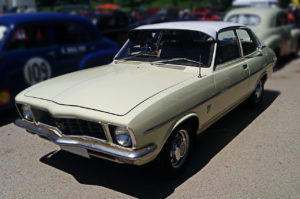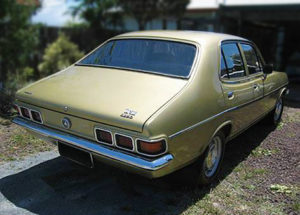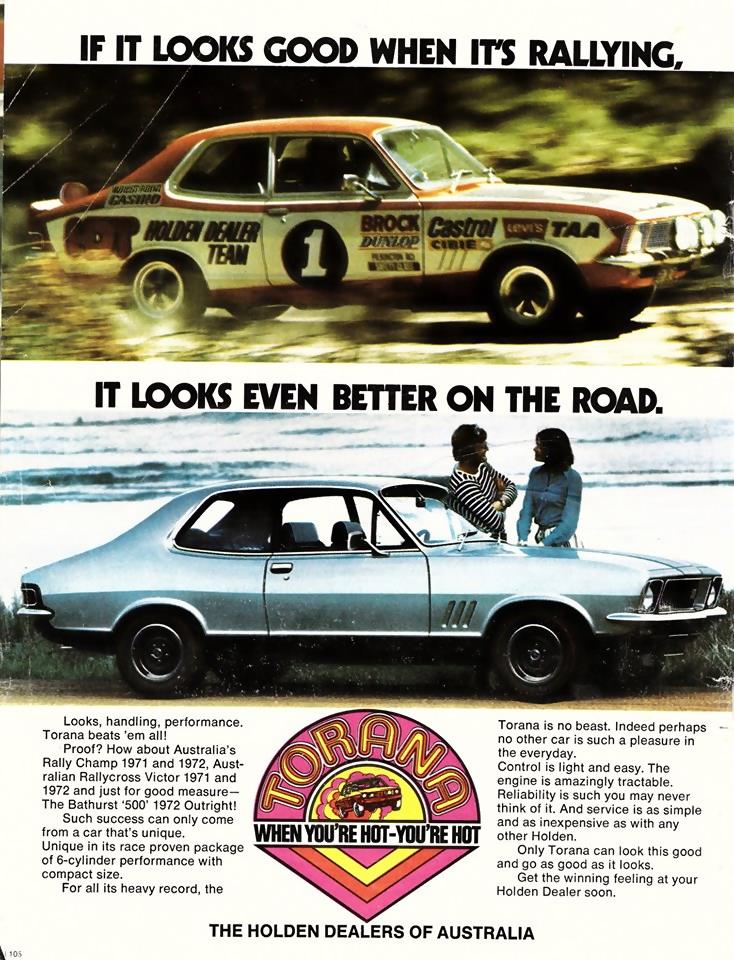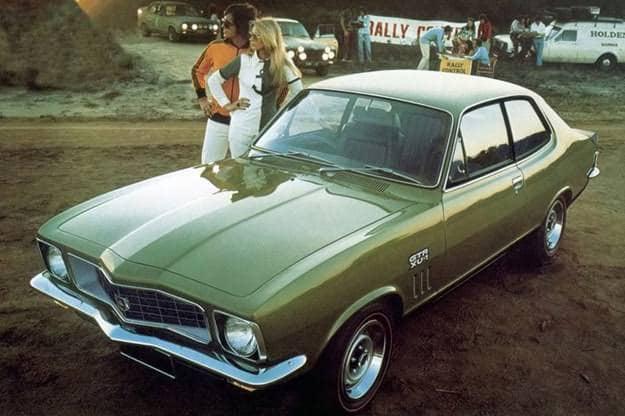The Holden LJ Torana
The second generation of Holden Torana’s included three vehicles: the LC, LJ and TA. The LJ Torana was the second model in the second generation of Torana’s. It launched in February of 1972. This version was introduced with a next generation six-cylinder transmission which became fairly standard with most of the large model Holden HQ vehicles. The LJ Torana had quite a few changes related to the engine itself, in fact the options were endless as shown below. This line-up of Torana’s had fitted steering columns and a fitted steering wheel. The headrests were all adjustable with interior absorbing sun visors. The outside of the 6-cylinder vehicles had a nice recessed plastic grille.
All models came equipped with a three piece tail light assembly, a new dash control layout with the ignition and steering lock on the column. Most of the instruments remained similar with a few minor changes such as the gauge positions and the radio was mounted in the centre of the dash now. All models had new suspension springs and shocks for a much improved ride and all seats and improved lateral support. The interior had trim making each new model much improved over the previous line-up.
 Holden LJ Torana 4 2-door
Holden LJ Torana 4 2-door
Model/Engine Line-up:
- Torana 1200 LJ (Model #: 82211): 4-cylindar 1200cc engine/2-door only
- Torana 1300 LJ Deluxe (Model #: 82411): 4-cylidner 1300cc engine/2-door or 4-door option/automatic transmission
- Torana 1600 LJ Deluxe (Model #: 82811): 4-cyindar 1600cc engine/2-door or 4-door option
- Torana 1760 LJ Deluxe (Model #: 82811): 4-cyindar 1760cc engine/2-door or 4-door option
- TORANA S LJ (Model #: 8231): 6-cylinder 2250cc engine and 2850cc engine options/2-door or 4-door option
- TORANA GTR LJ (Model #: 82911): 6-cylinder 3300cc engine (202)/2-door
- TORANA GTR-XU1 LJ (Model #: 82911): 6-cylinder 3300cc engine (202)/2-door
- 1973: 3300cc engine became available on S and SL (LC generation) versions
The 1300, 1600 and 1760 engine models of the LJ Torana were known as Deluxe models because they came equipped with both 2-door or 4-door model options and automatic transmission was available in the 1300 model, making this model extra special. The Torana S model came equipped with a six-cylinder 2250 or 2850 engine option and the 3300 engine was available in the GTR LJ model (also known as the 202 in the HQ). The gearbox was the same across the entire fleet.
 Holden LJ Torana 6 S 2-door
Holden LJ Torana 6 S 2-door
The 3300 engine was retro-fitted for a version of the LJ Torana geared more for racing modelled as the GTR XU-1. This engine allowed the vehicle to produce over 200 bhp (brake horsepower) (149 kW – kilowatt; 203 PS – pferdestärke). Holden equipped the LJ Torana GTR XU-1 with a 202-cc engine with larger triple carburettors, as well as a new close-ratio M20 4-speed Australian-made transmission. The M20 Australian transmission was more commonly called an Aussie 4-speed and sometimes called the M21 because of its commonality to the M21. This transmission gave the XU-1 a boost of power needed to challenge other race kings such as the Ford Falcon GTHO Phase III. The Ford made Falcon won the 1971 Hardie-Ferodo 500, which was an endurance car race for production cars held in Bathurst on an annual basis. It was time for the Torana to put it to the test.
In 1972, at a rainy Hardie-Ferodo 500, the HD Torana GTR XU-1 was able to beat the GT-HO Ford Falcon and claim victory! Peter Brock drove the lightweight Torana GTR XU-1 to victory becoming a legend in the making. He won five of ten Bathurst races in the Torona’s ten-year racing career at Bathurst.
 Holden LJ Torana GTR XU-1
Holden LJ Torana GTR XU-1
The Holden racing Dealer Team developed a second series to the GTR XU-1 that was 300 brake horsepower (224 kW – kilowatt; 304 PS – pferdestärke). This vehicle was extremely fast incorporating a 308ci V8-powered engine version of the GTR XU-1, which could reach speeds well past the original model. This vehicle was often referred to as the GTR XU-2. The second series in a line of fast cars being developed. The V8 Torana did race as did its predecessor. It was featured in the Sports Sedan Racing Series with Brock and Colin Bond at the wheel and it was road tested by the Holden Dear Team boss Harry Firth and young team engineer/driver Larry Perkins; however, this new race car never actually made it past the prototype stages. In June of 1972 an article published in the newspaper caused public controversy claiming that the three top vehicle manufactures were manufacturing 160 MPH Super Cars. The government’s reaction was appalling calling these cars ‘bullets on wheels’. Government organizers were calling for a ban on such cars. This backlash lead to the one of the largest announcements of GM’s Holden career. On June 30, 1972 Holden announced that he would abandon the plan to build and manufacture the V8 Torana. Following this move other manufactures followed suit abandoning their plans to develop their super cars as well (Ford and Chrysler). The next Bathurst raced as scheduled, but with previous versions of supercars. It was not until two years later did Holden introduce a V8 Torana. The LH Series was launched in 1974.
In 1973 the 3300c engine that was used in the GTR XU-1 was made available in the S and SL (LC generation) models. This engine was an option, while the 2850 became the standard in these two models. By this time the 1200c, 56 brake horsepower, engine was no longer used becoming discontinued. It was determined that the 4-cylinder/1300c engine would be the baseline model from there forward.
 Holden LJ Torana GTR
Holden LJ Torana GTR
It is estimated that the total production of the LJ Torana’s is equal to 81,813. Some of these were exported to New Zealand, but only the 6-cylidar models. New Zealand had a similar 4-zylindar that they were already manufacturing themselves, the Vauxhall Viva HC. Holden also sent the 2850SL model which included nice bucket seats with either four-speed floor shift or a three-speed automatic. It shipped in to New Zealand in CKD kit form for assembly upon arrival in 1973. This became the first Kiwi-built Torana.
An interesting note about the LJ Torana is that it actually formed the basis for South Korea’s Chevrolet 1700. Between 1972 and 1976 GM in Korea produced the Chevrolet 1700 which was a five-door station wagon. It had a 1,698cc/4-cylinder engine, which ended up somewhat of a failure for GM. It did not sale very well at all. In fact, only about 8,000 vehicles were produced and the main reason for failure was its high fuel consumption.
In 1976 GM (renamed to Saehan Motors) redesigned the vehicle and came out with the Camina, which had 1492cc engine for better fuel economy. Saehan Motors sold both the Camina and the Chevrolet 1700 at the same time. Unfortunately both vehicles were discontinued at the same time in 1978. Neither one recovered from the failure of the Chevrolet 1700. In fact, the Camina only sold just under 1,000 vehicles in those two years. Later Saehan would come out with the Saehan Gemini as a replacement in 1977, after the development of the Isuzu Gemini and the Holden Gemini in Australia.
 Holden LJ Torana 6 S 4-door
Holden LJ Torana 6 S 4-door
MINOR FEATURES
- Rear side blinker repeaters removed
- Electric kickdown
- GTR used GTS steering wheel
- Other models used HQ Kingswood steering wheel
- 1973 and 1974 models – orange front blinkers and parking lights
DIMENSIONS
| IMPERIAL | METRIC | ||||
| FUEL TANK | … | 8 GALLONS | … | 30 LITRES | |
| WHEELBASE | (4-CYL) | … | 95.8 INCHES | … | 2433 mm |
| WHEELBASE | (4-CYL) | … | 100 INCHES | … | 2540 mm |
| TRACK | (FRONT 4) | … | 51 INCHES | … | 1295 mm |
| TRACK | (FRONT 6) | … | 51.8 INCHES | … | 1316 mm |
| TRACK | (FRONT GTR) | … | 52.2 INCHES | … | 1326 mm |
| TRACK | (REAR 4) | … | 51 INCHES | … | 1295 mm |
| TRACK | (REAR 6) | … | 50.8 INCHES | … | 1290 mm |
| TRACK | (REAR GTR) | … | 51.2 INCHES | … | 1300 mm |
| HEIGHT | … | 53 INCHES | … | 1346 mm | |
| WIDTH | … | 63 INCHES | … | 1600 mm | |
| LENGTH | (4-CYL) | … | 162 INCHES | … | 4115 mm |
| LENGTH | (6-CYL) | … | 173 INCHES | … | 4394 mm |
PRODUCTION
| DOMESTIC | … | 70 176 |
| EXPORT (WHOLE) | … | 1 819 |
| EXPORT (CKD) | … | 9 818 |
| TOTAL | … | 81 813 |
ENGINE
| COMP. RATIO |
OUTPUT | ENG.NO. PREFIX |
|
| 1200 | 8.5 | 56 BHP | – |
| 1200HP | 9.0 | 69 BHP | – |
| 1300 | 8.5 | 62 BHP | – |
| 1600 OHC | 8.5 | 80 BHP | – |
| 1760 OHC | 7.3 | 80 BHP | – |
| 2250 LC | 7.8 | 90 BHP | CC |
| 2250 HCI | 9.2 | 95 BHP | CB |
| 2850 LC | 8.3 | 108 BHP | CD |
| 3300 LC | 7.8 | 129 BHP | JM |
| 3300 HC | 8.3 | 135 BHP | JL |
| 3300 XU-1 | 10.25 | 190 BHP | JP |
TRANSMISSION
| FOUR CYLINDER |
| FOUR SPEED MANUAL (FLOOR) |
| THREE SPEED AUTOMATIC (TRIMATIC FLOOR) |
| SIX CYLINDER |
| THREE SPEED MANUAL (COLUMN) |
| THREE SPEED MANUAL (FLOOR) |
| FOUR SPEED MANUAL (OPEL – FLOOR) |
| FOUR SPEED MANUAL (AUST – FLOOR) |
| THREE SPEED AUTOMATIC (TRIMATIC F/C) |
FINAL DRIVE
| RATIO – 3.98 (56 BHP AND FOUR SPEED MANUAL) |
| RATIO – 4.125 (56 BHP AUTO AND OTHER 4’s) |
| RATIO – 3.08, 3.36, 3.55 (6-CYLINDER) |
MODELS AND RELEASE DATES – 1973
| MODEL | 2-DOOR | 4-DOOR | RELEASED | AVAILABLE UNTIL |
PRICE AT RELEASE |
| TORANA 1200 | LJ/82211 | – | 4 FEB 1972 | TA – MAR 1974 | $2180 |
| TORANA 1300 DELUXE | LJ/82411 | LC/82469 | 4 FEB 1972 | TA – MAR 1974 | – |
| TORANA 1600 DELUXE | LJ/82811 | LC/82869 | 4 FEB 1972 | 1760 – OCT 1972 | – |
| TORANA 1760 DELUXE | LJ/82811 | LC/82869 | 1 OCT 1972 | TA – MAR 1974 | – |
| TORANA S (6) | LJ/82311 | LC/82369 | 4 FEB 1972 | LH – MAR 1974 | – |
| TORANA SL (6) | – | LC/82569 | 4 FEB 1972 | LH – MAR 1974 | – |
| TORANA GTR | LJ/82911 | – | 4 FEB 1972 | LH – MAR 1974 | $2920 |
| TORANA GTR-XU1 | LJ/82911 (XU1) |
– | 4 FEB 1972 | LH – MAR 1974 | – |
MODELS AND RELEASE DATES – 1973 +
| MODEL | 2-DOOR | 4-DOOR | RELEASED | AVAILABLE UNTIL |
PRICE AT RELEASE |
| TORANA 1200 | 8E11 | – | 4 FEB 1972 | TA – MAR 1974 | $2180 |
| TORANA 1300 DELUXE | 8F11 | 8F69 | 4 FEB 1972 | TA – MAR 1974 | – |
| TORANA 1600 DELUXE | 8F11 | 8F69 | 4 FEB 1972 | 1760 – OCT 1972 | – |
| TORANA 1760 DELUXE | 8F11 | 8F69 | 1 OCT 1972 | TA – MAR 1974 | – |
| TORANA S (6) | 8B11 | 8B69 | 4 FEB 1972 | LH – MAR 1974 | – |
| TORANA SL (6) | – | 8C69 | 4 FEB 1972 | LH – MAR 1974 | – |
| TORANA GTR | 8D11 | – | 4 FEB 1972 | LH – MAR 1974 | $2920 |
| TORANA GTR-XU1 | 8D11 (XU1) | – | 4 FEB 1972 | LH – MAR 1974 | – |



